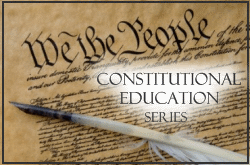 It’s important that we educate our children on the topics of politics, government, and the Constitution which governs our nation. This nine-part series attempts to remind us of some basic principles, lest they be forgotten by the next generation.
It’s important that we educate our children on the topics of politics, government, and the Constitution which governs our nation. This nine-part series attempts to remind us of some basic principles, lest they be forgotten by the next generation.At one time, many United States coins contained precious metal – either gold or silver. Ask anyone over the age of forty, and it is likely that they have some old silver coins tucked away in a drawer or shoebox somewhere. Coinage had real value at one time. The metal in a silver 1964 quarter might have really been worth twenty-five cents. Today, inflation and the price of precious metal make the melt value of that same quarter equivalent to $2.61. Contrast that with a newly-minted quarter, which contains both copper and nickel – but no precious metal – and has a melt value of just over two cents.
Until 1957, the government also used to print paper money which said “Silver Certificate” on it (they looked much like our currency does today – see above). You could actually go to the treasury and exchange it for the face value in real silver (look carefully at the picture above and you will see that it says, “Five Dollars in silver payable to the bearer on demand”). In later times, you could trade the certificate in for an equal value in silver dollars. But when the price of silver began to rise, and people began hoarding silver certificates, the government declared an end to this exchange practice in 1964. In fact, the United States has gone through a curious progression of backing its money against various metal standards – starting first with a dual gold and silver standard set by Alexander Hamilton. In 1873, the Coinage Act placed the US strictly on the gold standard (much to the silver miner’s dismay). But after the Great Depression started, the US reverted to the silver standard in 1933. Today’s paper currency is stamped with the words “Federal Reserve Note” and a dollar bill is worth a dollar only because the government says so (the same applies to our coins). It now has no connection to precious metal in any way.
An important event happened in 1913, which forever changed the way that money supply would be handled in our country. Some years before this date, there had been a series of minor financial panics (1873, 1893, 1907) and there was concern that a bank run (when a large portion of bank customers wish to withdraw all their money in cash) would leave people without the ability to get their hands on their money. One proposed way to prevent bank runs is to have a regulated money supply which “expands” when the situation demands it. In essence, more money is printed to give to people when they require it. So, the nation turned to the federal government in 1913 to create the Federal Reserve – a federal agency which is now responsible for monitoring and manipulating the money supply, regardless of the presence of gold or silver backing.
The reason for the creation of the Federal Reserve was simply to prevent the recurrence of financial panic and to manipulate the money supply in order to preserve stability. Yet, a mere sixteen years later, the stock market crashed again and the United States entered the worst depression in its history – the Great Depression of 1929.
An analysis of the price of goods over the history of our country shows that from 1789 to 1913, the prices of various goods remained virtually the same (with ups and downs along the way). But since the creation of the Federal Reserve in 1913, prices have risen an average of 20X. It’s true that wages have increased over that time, too. The reason for the increase in both is simply stated as inflation – which is defined as an increase in the overall supply of money. When the federal government stopped backing each coin or bill with precious metal, they essentially gave themselves the power to print money at will. But, as is evident, printing more money merely devalues the worth of each dollar. Wages rise, and prices rise – but is the government’s legalized manipulation of the money supply really creating stability? One could argue that it has had the opposite effect.
Here’s a simple comparison. The financial rules for the federal government are really no different than those of a typical American family. If you don’t have enough money for something, you probably should not buy it. If you must borrow the money, you should make sure that you have the means to pay it back in a reasonable amount of time. The government, even though it is very large and often difficult to understand, is not exempt from these basic principles. Imagine what would happen if each family simply printed the money that they need for everything, in the comfort of their living room – even if it were legal to do so! Common sense tells us that this system would not last long. Likewise, we should be warning our government officials of the problems that we all will encounter if they continue to spend, borrow and manipulate the money supply to their own ends.
Next article: What is the “General Welfare Clause” and should I like it? Back to the main index article.











No comments:
Post a Comment